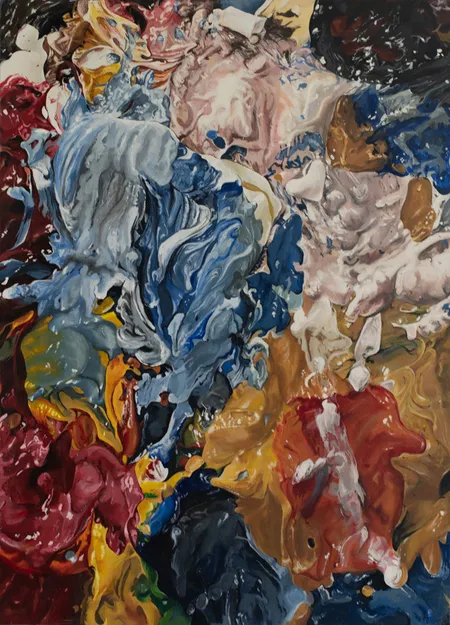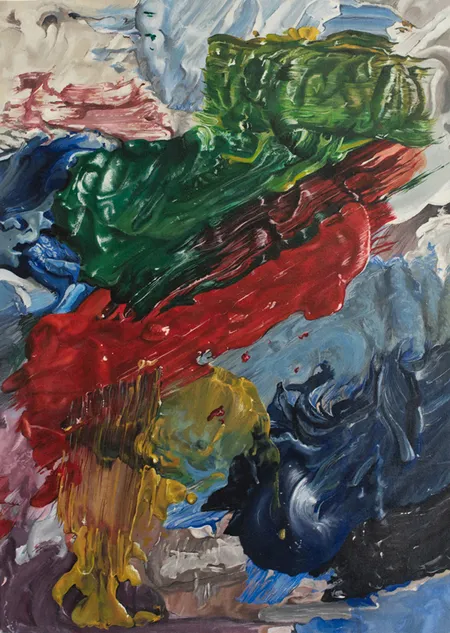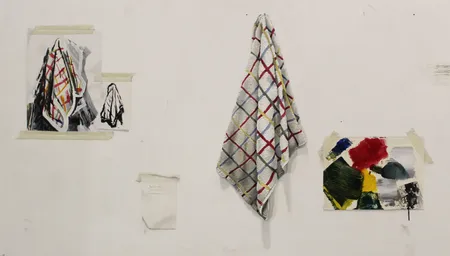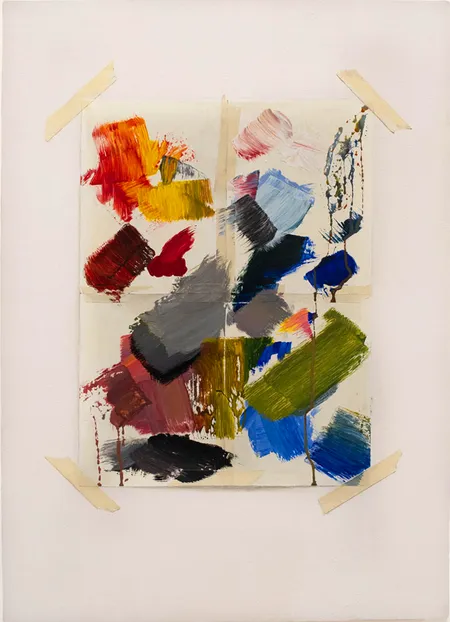Emma Matthews
Degree: Fine Art
University: Bath Spa University
Graduation Year: 2024
New Blood Art Commentary
Emma Matthews, a 2024 graduating artist from Bath Spa University, delves into the often-overlooked remnants of the artistic process, transforming them into the focal point of her work. Her practice is a meticulous exploration of the secondary and unintentional marks left behind in her studio—paint splatters, initial sketches, and paint palettes. By recreating these traces in the form of paintings and sculptures, Matthews elevates the method of making art, turning the process itself into the subject of her work.
Matthews employs the trompe l’oeil technique, a French term meaning 'trick of the eye,' to add an illusionistic element to her creations. This technique deceives viewers into believing that the painted subjects are real, only to reveal upon closer inspection that they are simulacrums, replacing reality with a meticulously crafted illusion. This hidden labor juxtaposes the seemingly unconstrained appearance of her work, creating a humorous paradox where the viewer engages with the art without immediately grasping its deeper meaning.
Her paintings, primarily executed in oil on MDF board, achieve a smooth finish that enhances the illusion. Matthews also paints directly onto ready-made objects from her studio, such as tables and chairs, further deceiving the audience. By refraining from positioning her works next to the real reference marks or objects they emulate, she creates autonomous pieces that stand as simulacrums of reality within a fine art context.
Emma Matthews' work is a testament to the unseen process of art-making, giving value to the inadvertent marks of creation and situating her practice within themes of trompe l’oeil, self-reference, and simulacrums. Her approach not only challenges the viewer's perception but also celebrates the laborious process behind the seemingly effortless marks, making her a compelling emerging artist to watch.
Artist Statement
Within my practice, I investigate the traces that are left behind when creating a piece of art. I recreate secondary and unintentional marks present in my studio, such as paint splatters, initial sketches, and paint palettes, in the form of paintings and sculptures as they represent the unseen process of making art. By intentionally recreating these marks I elevate the method of making art by turning the process into the subject of my work, therefore giving these marks value by contextualising them within a fine art setting. I apply this methodology to create self-referential and cyclical outcomes as I use the marks made from each work to generate and inform my next outcome. My representations of these overlooked marks are created in a trompe l’oeil (a French term for ‘trick of the eye’) art technique which enables me to add an illusionistic element to my work as the viewer is deceived into thinking the painted subjects are real and therefore unassuming. It is only until closer examination of my outcomes that a shift in perspective takes place, revealing that my works are simulacrums replacing reality. My paintings and sculptures therefore encompass hours of labour that demand to go unnoticed for the deception to work. This hidden labour juxtaposes the seemingly unconstrained appearance of my work and is what elevates these marks from inadvertent to intentional. This humorous paradox of viewing my work without necessarily “seeing” the work’s meaning situates my practice within a context that explores themes surrounding trompe l’oeils, self-reference, and simulacrums. I create both paintings and sculptures to explore the themes present in my work. Within my paintings, I primarily use oil paints to paint onto boards, which I use in place of canvas, and directly onto ready-made objects from my studio to create both two and three-dimensional self-referential trompe l’oeils. For the illusion to work, trompe l’oeils require the painting’s surface to be unconsciously perceived by the viewer and I achieve this by painting on MDF board which I prime to achieve a smooth finish. Additionally, painting directly onto ready-made objects, such as my studio table and chair, allows me to deceive the audience further. When exhibiting my work, I consciously refrain from positioning my paintings and sculptures next to the real reference marks/ objects they emulate. This is because I want to replace the marks with its representation, in doing so creating simulacrums of reality which gives my work autonomy within its fine art context.




